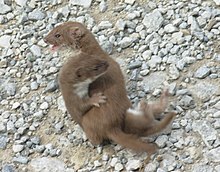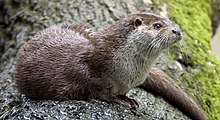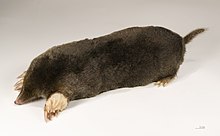List of mammals of Andorra
This is a list of the mammal species recorded in Andorra. There are seventeen mammal species in Andorra, of which two are vulnerable and one is near threatened.[1]
The following tags are used to highlight each species' conservation status as assessed by the International Union for Conservation of Nature:
| EX | Extinct | No reasonable doubt that the last individual has died. |
| EW | Extinct in the wild | Known only to survive in captivity or as a naturalized populations well outside its previous range. |
| CR | Critically endangered | The species is in imminent risk of extinction in the wild. |
| EN | Endangered | The species is facing an extremely high risk of extinction in the wild. |
| VU | Vulnerable | The species is facing a high risk of extinction in the wild. |
| NT | Near threatened | The species does not meet any of the criteria that would categorise it as risking extinction but it is likely to do so in the future. |
| LC | Least concern | There are no current identifiable risks to the species. |
| DD | Data deficient | There is inadequate information to make an assessment of the risks to this species. |
Subclass: Theria
Infraclass: Eutheria
Order: Artiodactyla (even-toed ungulates)

The even-toed ungulates are ungulates whose weight is borne about equally by the third and fourth toes, rather than mostly or entirely by the third as in perissodactyls. There are about 220 artiodactyl species, including many that are of great economic importance to humans.
- Family: Suidae (pigs)
- Family: Cervidae (deer)
- Subfamily: Capreolinae
Order: Carnivora (carnivorans)


There are over 260 species of carnivorans, the majority of which feed primarily on meat. They have a characteristic skull shape and dentition.
- Suborder: Caniformia
- Family: Canidae (dogs, foxes)
- Family: Mustelidae (mustelids, weasels and stoats)
- Genus: Mustela
- Least weasel, M. nivalis LC
- European polecat, M. putorius LC
- Stoat, M. erminea LC
- Genus: Lutra
- Eurasian badger, M. meles LC[3]
- Genus: Mustela
- Family: Ursidae (bears)
- Genus: Ursus
- Brown bear, U. arctos LC[4]
- Genus: Ursus
Order: Chiroptera (bats)

The bats' most distinguishing feature is that their forelimbs are developed as wings, making them the only mammals capable of flight. Bat species account for about 20% of all mammals.
- Family: Vespertilionidae
- Subfamily: Myotinae
- Genus: Myotis
- Greater mouse-eared bat, M. myotis LC[5]
- Genus: Myotis
- Subfamily: Vespertilioninae
- Genus: Barbastella
- Barbastelle, B. barbastellus
- Genus: Nyctalus
- Lesser noctule, N. leisleri LC[6]
- Genus: Barbastella
- Subfamily: Myotinae
- Family: Rhinolophidae
- Subfamily: Rhinolophinae
- Genus: Rhinolophus
- Lesser horseshoe bat, R. hipposideros LC
- Genus: Rhinolophus
- Subfamily: Rhinolophinae
Order: Lagomorpha (hares and rabbits)
- Family: Leporidae
- Genus: Lepus
- European hare, L. europaeus LC[7]
- Genus: Oryctolagus
- European rabbit, O. cuniculus LC[8]
- Genus: Lepus
Order: Rodentia (rodents)
Rodents make up the largest order of mammals, with over 40 percent of mammalian species. They have two incisors in the upper and lower jaw which grow continually and must be kept short by gnawing.
- Suborder: Myomorpha
- Family: Cricetidae
- Subfamily: Arvicolinae
- Genus: Microtus
- Field vole, Microtus agrestis LC
- Common vole, Microtus arvalis LC
- Genus: Microtus
- Subfamily: Arvicolinae
- Family: Muridae (mice, rats, gerbils, etc.)
- Subfamily: Murinae
- Genus: Apodemus
- Yellow-necked mouse, Apodemus flavicollis LC
- Wood mouse, Apodemus sylvaticus LC
- Genus: Apodemus
- Subfamily: Murinae
- Family: Cricetidae
Order: Soricomorpha (shrews, moles, and solenodons)

The "shrew-forms" are insectivorous mammals. The shrews and solenodons closely resemble mice while the moles are stout-bodied burrowers.
- Family: Talpidae (moles)
- Subfamily: Talpinae
- Genus: Talpa
- European mole, T. europaea LC
- Genus: Galemys
- Pyrenean desman, G. pyrenaicus VU[9]
- Genus: Talpa
- Subfamily: Talpinae
See also
- List of chordate orders
- List of prehistoric mammals
- Mammal classification
- List of mammals described in the 2000s
References
- ^ This list is derived from the IUCN Red List which lists species of mammals and includes those mammals that have recently been classified as extinct (since 1500 AD). The taxonomy and naming of the individual species is based on those used in existing Wikipedia articles as of 21 May 2007 and supplemented by the common names and taxonomy from the IUCN, Smithsonian Institution, or University of Michigan where no Wikipedia article was available.
- ^ Hoffmann, M.; Sillero-Zubiri, C. (2016). "Vulpes vulpes". The IUCN Red List of Threatened Species. 2016: e.T23062A46190249. doi:10.2305/IUCN.UK.2016-1.RLTS.T23062A46190249.en.
- ^ Kranz, A.; Abramov, A. V.; Herrero, J.; Maran, T. (2016). "Meles meles". The IUCN Red List of Threatened Species. 2016: e.T29673A45203002.
{{cite journal}}: Unknown parameter|last-author-amp=ignored (|name-list-style=suggested) (help) - ^ McLellan, B. N.; Proctor, M. F.; Huber, D.; Michel, S. (2017). "Ursus arctos". The IUCN Red List of Threatened Species. 2017: e.T41688A121229971. doi:10.2305/IUCN.UK.2017-3.RLTS.T41688A121229971.en.
{{cite journal}}: Unknown parameter|last-author-amp=ignored (|name-list-style=suggested) (help) - ^ Coroiu, I.; Juste, J. & Paunović, M. (2016). "Myotis myotis". The IUCN Red List of Threatened Species. 2016: e.T14133A22051759. doi:10.2305/IUCN.UK.2016-2.RLTS.T14133A22051759.en.
{{cite journal}}: CS1 maint: multiple names: authors list (link) - ^ Juste, J. & Paunović, M. (2016). "Nyctalus leisleri". The IUCN Red List of Threatened Species. 2016: e.T14919A22016159. doi:10.2305/IUCN.UK.2016-2.RLTS.T14919A22016159.en.
{{cite journal}}: CS1 maint: multiple names: authors list (link) {{cite iucn}}: error: malformed |page= identifier (help) - ^ Hacklande, K.; Schai-Braun, S. (2019). "Lepus europaeus". The IUCN Red List of Threatened Species. 2019: e.T41280A45187424. doi:10.2305/IUCN.UK.2019-1.RLTS.T41280A45187424.en.
- ^ Smith, A.T.; Boyer, A.F. (2008). "Oryctolagus cuniculus". IUCN Red List of Threatened Species. 2008: e.T41291A10415170. doi:10.2305/IUCN.UK.2008.RLTS.T41291A10415170.en.
- ^ Fernandes, M.; Herrero, J.; Aulagnier, S.; Amori, G. (2008). "Galemys pyrenaicus". The IUCN Red List of Threatened Species. 2008: e.T8826A12934876.
{{cite journal}}: Unknown parameter|last-author-amp=ignored (|name-list-style=suggested) (help)
External links
- "Mammal Species of the World". Smithsonian National Museum of Natural History. 2005. Archived from the original on 27 April 2007. Retrieved 22 May 2007.
- "Animal Diversity Web". University of Michigan Museum of Zoology. 1995–2006. Retrieved 22 May 2007.
